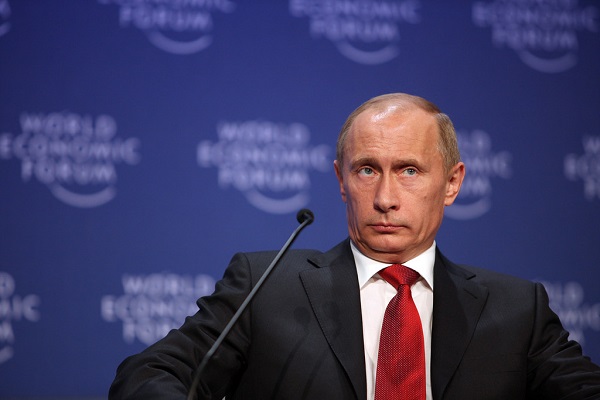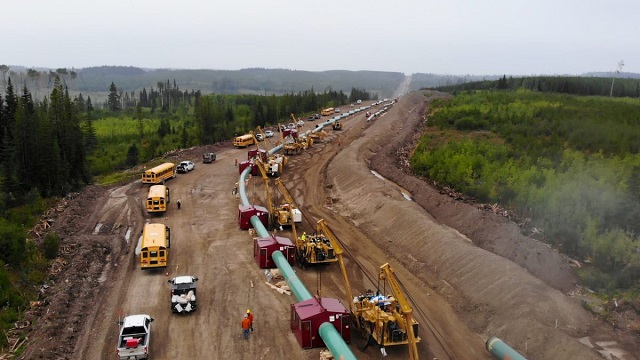Energy
Putin’s uranium export restrictions are a gift for Canada

From Resource Works
“The World Nuclear Association says Canada could now play a major role in meeting future world demand, as several key nations eye nuclear energy to meet growing demand for electrical power and for power production that does not use fossil fuels.”
Good to see Russian President Vladimir Putin proposing restrictions on Russian exports of uranium in retaliation for Western sanctions on Russian oil, gas, and LNG.
“Please take a look at some of the types of goods that we supply to the world market,” he told Prime Minister Mikhail Mishustin. “Maybe we should think about certain restrictions — uranium, titanium, nickel.”
Russia is the world’s sixth-largest uranium producer and has about 44% of global uranium enrichment capacity.
Canada, once the world’s largest uranium producer, is now the world’s second-largest producer of uranium, behind Kazakhstan. Canada accounts for roughly 13% of total global output, and Putin’s comment quickly increased the value of shares of our uranium producers.
The World Nuclear Association says Canada could now play a major role in meeting future world demand, as several key nations eye nuclear energy to meet growing demand for electrical power and for power production that does not use fossil fuels.
The Cigar Lake mine in Saskatchewan is one of the world’s richest in uranium. The McClean Lake mill, which processes it, is operated by a subsidiary of France’s Orano and sells 40% of its production to the French electric utility company, EDF.
Australia’s Paladin Energy moved in June to buy Canadian uranium explorer Fission Uranium for $1.14 billion. That purchase is now undergoing a national security review ordered by Ottawa.
Canada’s 34 “critical metals” and minerals have been taking up more of Ottawa’s interest, with the feds pushing their Critical Minerals Strategy and making it harder for foreign firms to acquire Canada’s biggest mining companies.
Now, Saskatchewan has vowed to compete with China in processing and production of rare earths and to become the prime North American source for metals used to make magnets for electric vehicles and wind turbines.
All this comes as one outlook says the global mining industry will require US$2.1 trillion in new investments by 2050 to meet the raw material demands of a net-zero-emissions world. The report says critical energy-transition metals, including aluminum, copper, and lithium, could face supply deficits this decade—some as early as this year.
In Canada, a new report from consultants EY says “capital is king” and is the top risk facing the mining industry this year, as tough financing and economic conditions make it more difficult to deliver the metals needed for the energy transition.
“We need about $1 trillion in investment to produce enough metals for the energy transition,” says Theo Yameogo, EY Americas and Canada mining and metals leader. “We haven’t seen that coming in. Now it’s the #1 (risk) because people are really worried. We’ve seen some M&A, but we haven’t seen direct investment in the mining sector.”
This points to the need for Canadian governments to simplify and speed up regulatory processes for new mines. It can take 12 to 15 years before a proposed mine can get through all the red tape from assorted governments and get into its first production. Jonathan Wilkinson, federal minister of energy and natural resources, announced in March that Canada would soon launch an Action Plan to speed up the mine-permitting process. But we still don’t see it.
Carbon Tax
Carney fails to undo Trudeau’s devastating energy policies

From the Fraser Institute
By Tegan Hill and Elmira Aliakbari
On the campaign trail and after he became prime minister, Mark Carney has repeatedly promised to make Canada an “energy superpower.” But, as evidenced by its first budget, the Carney government has simply reaffirmed the failed plans of the past decade and embraced the damaging energy policies of the Trudeau government.
First, consider the Trudeau government’s policy legacy. There’s Bill C-69 (the “no pipelines act”), the new electricity regulations (which aim to phase out natural gas as a power source starting this year), Bill C-48 (which bans large oil tankers off British Columbia’s northern coast and limit Canadian exports to international markets), the cap on emissions only from the oil and gas sector (even though greenhouse gas emissions have the same effect on the environment regardless of the source), stricter regulations for methane emissions (again, impacting the oil and gas sector), and numerous “net-zero” policies.
According to a recent analysis, fully implementing these measures under Trudeau government’s emissions reduction plan would result in 164,000 job losses and shrink Canada’s economic output by 6.2 per cent by the end of the decade compared to a scenario where we don’t have these policies in effect. For Canadian workers, this will mean losing $6,700 (annually, on average) by 2030.
Unfortunately, the Carney government’s budget offers no retreat from these damaging policies. While Carney scrapped the consumer carbon tax, he plans to “strengthen” the carbon tax on industrial emitters and the cost will be passed along to everyday Canadians—so the carbon tax will still cost you, it just won’t be visible.
There’s also been a lot of buzz over the possible removal of the oil and gas emissions cap. But to be clear, the budget reads: “Effective carbon markets, enhanced oil and gas methane regulations, and the deployment at scale of technologies such as carbon capture and storage would create the circumstances whereby the oil and gas emissions cap would no longer be required as it would have marginal value in reducing emissions.” Put simply, the cap remains in place, and based on the budget, the government has no real plans to remove it.
Again, the cap singles out one source (the oil and gas sector) of carbon emissions, even when reducing emissions in other sectors may come at a lower cost. For example, suppose it costs $100 to reduce a tonne of emissions from the oil and gas sector, but in another sector, it costs only $25 a tonne. Why force emissions reductions in a single sector that may come at a higher cost? An emission is an emission regardless of were it comes from. Moreover, like all these policies, the cap will likely shrink the Canadian economy. According to a 2024 Deloitte study, from 2030 to 2040, the cap will shrink the Canadian economy (measured by inflation-adjusted GDP) by $280 billion, and result in lower wages, job losses and a decline in tax revenue.
At the same time, the Carney government plans to continue to throw money at a range of “green” spending and tax initiatives. But since 2014, the combined spending and forgone revenue (due to tax credits, etc.) by Ottawa and provincial governments in Ontario, Quebec, British Columbia and Alberta totals at least $158 billion to promote the so-called “green economy.” Yet despite this massive spending, the green sector’s contribution to Canada’s economy has barely changed, from 3.1 per cent of Canada’s economic output in 2014 to 3.6 per cent in 2023.
In his first budget, Prime Minister Carney largely stuck to the Trudeau government playbook on energy and climate policy. Ottawa will continue to funnel taxpayer dollars to the “green economy” while restricting the oil and gas sector and hamstringing Canada’s economic potential. So much for becoming an energy superpower.
Business
Large-scale energy investments remain a pipe dream

I view the recent announcements by the Government of Canada as window dressing, and not addressing the fundamental issue which is that projects are drowning in bureaucratic red tape and regulatory overburden. We don’t need them picking winners and losers, a fool’s errand in my opinion, but rather make it easier to do business within Canada and stop the hemorrhaging of Foreign Direct Investment from this country.
Thanks for reading William’s Substack!
Subscribe for free to receive new posts and support my work.
Changes are afoot—reportedly, carve-outs and tweaks to federal regulations that would help attract investment in a new oil pipeline from Alberta. But any private proponent to come out of this deal will presumably be handpicked to advance through the narrow Bill C-5 window, aided by one-off fixes and exemptions.
That approach can only move us so far. It doesn’t address the underlying problem.
Anyone in the investment world will tell you a patchwork of adjustments is nowhere near enough to unlock the large-scale energy investment this country needs. And from that investor’s perspective, the horizon stretches far beyond a single political cycle. Even if this government promises clarity today in the much-anticipated memorandum of understanding (MOU), who knows whether it will be around by the time any major proposal actually moves forward.
With all of the talk of “nation-building” projects, I have often been asked what my thoughts are about what we must see from the federal government.
The energy sector is the file the feds have to get right. It is by far the largest component of Canadian exports, with oil accounting for $147 billion in 2024 (20 percent of all exports), and energy as a whole accounting for $227 billion of exports (30 percent of all exports).
Furthermore, we are home to some of the largest resource reserves in the world, including oil (third-largest in proven reserves) and natural gas (ninth-largest). Canada needs to wholeheartedly embrace that. Natural resource exceptionalism is exactly what Canada is, and we should be proud of it.
One of the most important factors that drives investment is commodity prices. But that is set by market forces.
Beyond that, I have always said that the two most important things one considers before looking at a project are the rule of law and regulatory certainty.
The Liberal government has been obtuse when it comes to whether it will continue the West Coast tanker ban (Bill C-48) or lift it to make way for a pipeline. But nobody will propose a pipeline without the regulatory and legal certainty that they will not be seriously hindered should they propose to build one.
Meanwhile, the proposed emissions cap is something that sets an incredibly negative tone, a sentiment that is the most influential factor in ensuring funds flow. Finally, the Impact Assessment Act, often referred to as the “no more pipelines bill” (Bill C-69), has started to blur the lines between provincial and federal authority.
All three are supposedly on the table for tweaks or carve-outs. But that may not be enough.
It is interesting that Norway—a country that built its wealth on oil and natural gas—has adopted the mantra that as long as oil is a part of the global economy, it will be the last producer standing. It does so while marrying conventional energy with lower-carbon standards. We should be more like Norway.
Rather than constantly speaking down to the sector, the Canadian government should embrace the wealth that this represents and adopt a similar narrative.
The sector isn’t looking for handouts. Rather, it is looking for certainty, and a government proud of the work that they do and is willing to say so to Canada and the rest of the world. Foreign direct investment outflows have been a huge issue for Canada, and one of the bigger drags on our economy.
Almost all of the major project announcements Prime Minister Mark Carney has made to date have been about existing projects, often decades in the making, which are not really “additive” to the economy and are reflective of the regulatory overburden that industry faces en masse.
I have always said governments are about setting the rules of the game, while it is up to businesses to decide whether they wish to participate or to pick up the ball and look elsewhere.
Capital is mobile and will pursue the best risk-adjusted returns it can find. But the flow of capital from our country proves that Canada is viewed as just too risky for investors.
The government’s job is not to try to pick winners and losers. History has shown that governments are horrible at that. Rather, it should create a risk-appropriate environment with stable and capital-attractive rules in place, and then get out of the way and see where the chips fall.
Link to The Hub article: Large-scale energy investments remain a pipe dream
Formerly the head of institutional equity research at FirstEnergy Capital Corp and ATB Capital Markets. I have been involved in the energy sector in either the sell side or corporately for over 25 years
Thanks for reading William’s Substack!
Subscribe for free to receive new posts and support my work.
-

 Alberta17 hours ago
Alberta17 hours agoPremier Smith explains how private clinics will be introduced in Alberta
-

 Health2 days ago
Health2 days agoTens of thousands are dying on waiting lists following decades of media reluctance to debate healthcare
-

 Alberta16 hours ago
Alberta16 hours agoAlberta introducing dual practice health care model to increase options and shorten wait times while promising protection for publicly funded services
-

 Aristotle Foundation13 hours ago
Aristotle Foundation13 hours agoWe’re all “settlers”
-

 Opinion2 days ago
Opinion2 days agoLandmark 2025 Study Says Near-Death Experiences Can’t Be Explained Away
-

 Business16 hours ago
Business16 hours agoUS Supreme Court may end ‘emergency’ tariffs, but that won’t stop the President
-

 Business2 days ago
Business2 days agoBudget 2025: Ottawa Fakes a Pivot and Still Spends Like Trudeau
-

 Indigenous9 hours ago
Indigenous9 hours agoIndigenous activist wins landmark court ruling for financial transparency





